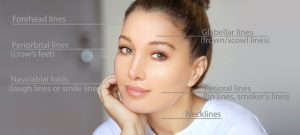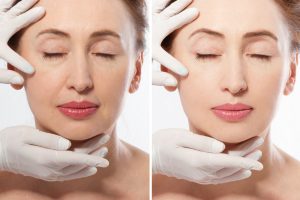Also Serving Facial Filler Patients in Everett & Bellingham
 Volume Restoration is a non-surgical procedure that is achieved through the injection of substances that add volume back into the skin. These include dermal fillers and fat transfer. Dermal fillers are biocompatible products that are injected into the deepest part of the skin to soften wrinkles and sometimes even support the structure of the skin. For some facial areas, like under the eyes, injections are done even deeper to fill in and improve hollow contours.
Volume Restoration is a non-surgical procedure that is achieved through the injection of substances that add volume back into the skin. These include dermal fillers and fat transfer. Dermal fillers are biocompatible products that are injected into the deepest part of the skin to soften wrinkles and sometimes even support the structure of the skin. For some facial areas, like under the eyes, injections are done even deeper to fill in and improve hollow contours.
Fat transfer involves removing fat cells from the lower part of the body (usually the abdomen) and injecting them into the face to replace lost volume.
At Cascade Facial Surgery, Dr. Jonathan Grant treats every patient as a unique individual. He will evaluate your skin and may suggest a combination of dermal fillers to provide the results you want. He is an expert injector who can deliver a natural-looking result that is not overdone.
Types of Facial Fillers
Restylane®
Restylane® is formulated with hyaluronic acid to add volume and fullness to the skin, smoothing away wrinkles and plumping up saggy or droopy areas of the face. Restylane® Defyne is specifically designed to volumize the cheeks and Restylane® Refyne smooths lines around the mouth.
Revanesse Versa
Like Restylane®, Revanesse Versa is made with hyaluronic acid to smooth lines and wrinkles. Revanesse Versa is unique in that its formula includes spherical particles that promote smooth, long-lasting results.
Juvéderm®
Juvéderm® is another popular hyaluronic acid-based filler commonly used to fill in unwanted wrinkles and enhance the lips, cheeks and jawline. There are Juvéderm® products specifically designed for plumping the lips, cheeks and nasolabial folds.
Radiesse®
Radiesse® is formulated with calcium hydroxyapatite microspheres suspended in a gel; the microspheres create a lattice-like framework underneath the skin. The filler immediately adds volume to the treated area while simultaneously prompting the body to create its own collagen to fill in the framework.
Fat Grafting
Facial fat grafting involves using unwanted fat from the abdomen or thighs and injecting it into the areas of the face that need volume and fullness. Unlike fillers, the fat develops a blood supply for long-lasting results.
Who is a candidate for Facial Fillers?
Candidates for volume restoration are those with signs of aging such as:
- Nasolabial folds (“smile lines” that run from the nose to the mouth)
- Marionette lines (wrinkles that run from the corners of the mouth to the chin)
- Dark rings under the eyes (tear troughs)
- Flattened cheekbones due to gravity and volume loss overtime
- Other lines and wrinkles on the face, neck, or hands
- Thin lips
How long do fat transfer facial fillers last?
Fillers last 3-24 months depending on the area being treated and the type of filler used. Fat transfer results are permanent, typically one third to half the volume of fat injected survives transfer for permanent volume restoration. The surviving fat will age like other fat cells that have always been in the face.
Does facial filler treatment hurt?
For fillers a topical numbing cream is applied to help minimize any discomfort. For fat transfer local anesthetic is injected to the area where the fat is being harvested, and to the area of the face where it is injecting.
What is the Recovery like?
 Typically with fillers, you may get bruising from the injections and/or mild swelling. This usually dissipates within 48-72 hours. With fat transfer you may have some discomfort in the area the fat was harvested from. This is manageable with over the counter medication in most instances. Fat transfer swelling typically peaks within a week and gradually dissipates over several weeks. Fat transfer does take more patience than dermal fillers in terms of recovery, but most fat transfer patients are back to work or regular daily activity within 2-3 weeks.
Typically with fillers, you may get bruising from the injections and/or mild swelling. This usually dissipates within 48-72 hours. With fat transfer you may have some discomfort in the area the fat was harvested from. This is manageable with over the counter medication in most instances. Fat transfer swelling typically peaks within a week and gradually dissipates over several weeks. Fat transfer does take more patience than dermal fillers in terms of recovery, but most fat transfer patients are back to work or regular daily activity within 2-3 weeks.
Frequently Asked Questions About Facial Fillers
What Areas Can Dermal Fillers Treat?
Dermal fillers are incredibly versatile. They can add volume to your cheeks, plump your lips, smooth out wrinkles, and even define your jawline.
Some fillers address hollows under your eyes or refine your nose or chin shape without surgery. They can even restore the appearance of bony-looking hands.
Can I Get Botox® and Fillers at the Same Time?
Yes, you can! Botox® and dermal fillers complement each other beautifully. Botox® relaxes muscles to reduce dynamic (movement-related) wrinkles, while fillers restore static wrinkles (those due to lost volume.) Combining both treatments creates a balanced, youthful look.
What Is the Right Age to Get Dermal Fillers?
There’s no one-size-fits-all answer to this question. Many people start fillers in their late 20s or early 30s to address early signs of aging or enhance their natural features.
Others wait until later in life to restore lost volume or make a change they’ve always desired. Dr. Grant will evaluate your unique needs and recommend the best approach.
How Long Does a Dermal Filler Appointment Take?
A dermal filler appointment is quick and convenient. Treatment typically takes 30-60 minutes. This makes fillers an ideal lunchtime treatment, allowing you to return to your daily routine immediately.
Can Dermal Fillers Look Natural?
Yes, dermal fillers can look natural—especially in the expert hands of Dr. Grant. The key is precision and understanding facial anatomy.
Dr. Grant tailors each treatment to your unique features, ensuring you look refreshed and radiant, never overdone.
How Long Will My Fillers Last?
The longevity of your fillers depends on the type of filler and the area treated. Hyaluronic acid fillers can last 6-24 months, while Radiesse® usually lasts at least a year.
For longer-lasting results, fat transfer is an option. About one-third to half of the transferred fat survives; these results are permanent.
Do Dermal Filler Injections Hurt?
Most patients find dermal filler injections very tolerable. Dr. Grant uses ultra-fine needles to ensure your comfort. Our specialists usually numb the area with a topical anesthetic beforehand, making the needle sticks much more comfortable.
In addition, most dermal fillers have an anesthetic (lidocaine) built into the formula to reduce discomfort further.
Are Dermal Fillers Reversible?
Yes, many dermal fillers are reversible. Hyaluronic acid fillers, for example, can be dissolved with an enzyme called hyaluronidase if needed. This adds an extra layer of reassurance, knowing your results can be adjusted if necessary.
What Should I Avoid Before and After Filler Treatment?
Before your treatment, avoid blood-thinning medications like aspirin and ibuprofen, as well as alcohol, to minimize bruising.
After your treatment, skip strenuous exercise and heat exposure for at least a day. Avoid touching the treated area unless otherwise directed by Dr. Grant.
How Do I Choose the Right Provider for Dermal Fillers?
If you want natural, realistic-looking dermal filler results, it starts with choosing the right specialist. Look for a skilled injector like Dr. Grant, who has extensive experience and a deep understanding of facial anatomy.
Make sure your chosen provider has some before and after photos, too. You can use these photos to gauge how the same treatment might look for you. Our photo gallery shows many remarkable results, including in areas many specialists struggle to treat effectively. Dr. Grant is a master surgeon and non-surgical expert, too, so you can count on him for results you’ll love.
Are dermal fillers safe?
Our practice only uses fillers that have been FDA approved for safe use and extensively studied. In the right candidates, serious side effects from dermal fillers are very unusual.
What is the difference between fillers and Botox®?
Fillers and Botox® are both wrinkle-reducing injectables. However, there is a notable difference in how they work.
Fillers instantly add volume to plump up the treated area. They are commonly used for folds and creases around the nose, mouth and chin, as well as under the eyes that result from the breakdown of collagen.
Botox® temporarily relaxes targeted facial muscles to smooth creases caused by repeated facial expressions. These wrinkles naturally occur around the corners of the eyes, on the forehead and in between the eyebrows.
Is facial fat grafting performed differently for men?
Yes, facial fat grafting is tailored to the needs of the individual patient. Dr. Grant tends to take a more conservative approach when volumizing the male face. Fat grafting is particularly useful for adding definition to the jawline so it looks more masculine and replacing volume loss in areas of the cheek where hollowness can make us look more tired than we feel.
How will gaining or losing weight affect my fat grafting results?
Minimal weight gain or loss (i.e., 20 pounds or less) will not have a noticeable effect on the results of fat grafting.
Is there any downtime after filler treatment?
No, you can immediately resume most of your daily activities right after your filler treatment. You should postpone strenuous exercise or activities until the day after treatment and avoid touching or pressing on the treated area for three days unless we tell you otherwise.
How soon will I see the results of my filler treatment?
The initial results of filler treatment can be seen almost instantly.
How much do dermal fillers cost?
The cost of treatment depends on the type and amount of dermal filler required. During your consultation, we can lay out a proposed treatment plan and advise of the projected costs. Rest assured that our pricing is very competitive and we never cut corners on the quality of care.
Learn More
If you are interested in injectables in the Western Washington area, contact us to find out if you’re a good candidate for the procedure.
Contact Us Today!






